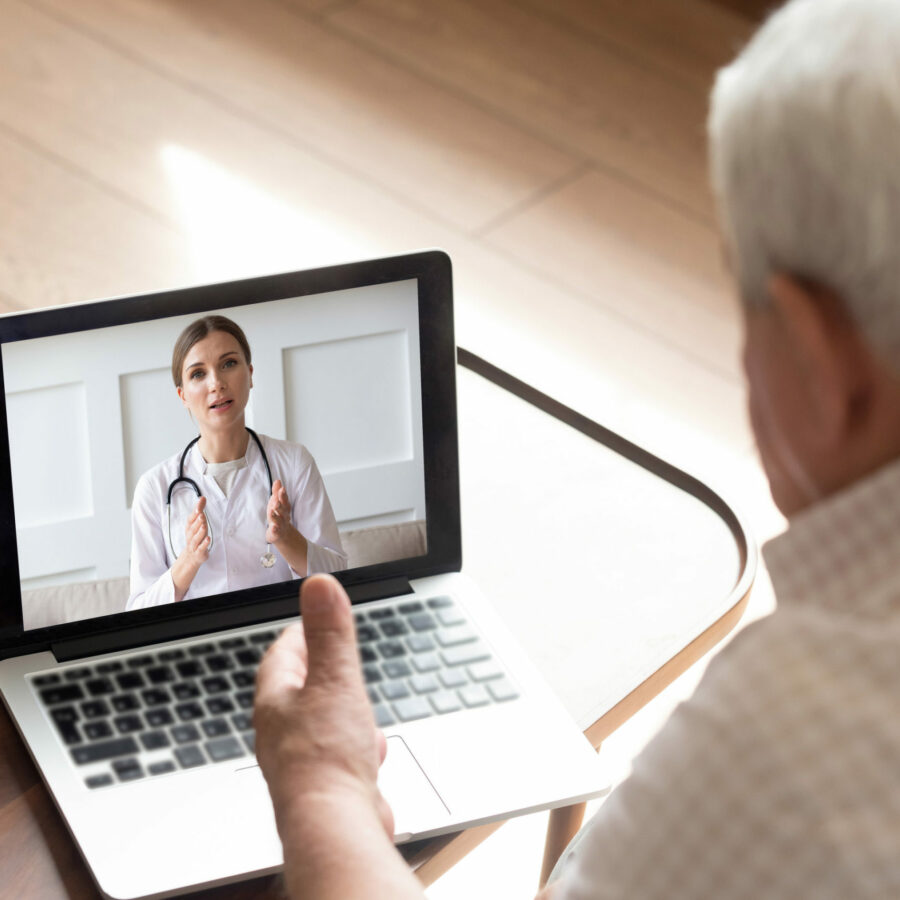The COVID-19 pandemic has dramatically altered our lives. This is particularly true for senior adults who require medical care, often for chronic conditions that cannot be ignored even as they remain in their homes to avoid possible exposure to the virus in a doctor’s office.
Telemedicine enables health care providers to remotely deliver clinical health services and information to patients via interactive and video telecommunications through devices like smartphones, tablets, home computers, or laptops. The connection between patients and care providers is through a program, app, or web site with video and audio capabilities.
Prior to the appointment, patients will receive a link or instructions as to how and when to set up the appointment. When the connection is made the patient may be placed in a virtual waiting room.
What Happens During the Appointment?
The first person with whom the patient interacts could be a nurse or medical assistant, who will gather information before the doctor appears. Aside from the reasons that prompted the appointment request, other questions may be for background information if the doctor is not familiar with the patient. This may include:
- Medical history, including chronic conditions
- Prescriptions, over-the-counter drugs, herbal supplements taken
- The patient’s pharmacy phone number and address
- Primary doctor’s name and contact information
- Insurance or credit card information
How to Prepare for the Appointment
If you or your family caregiver do not know if access to telemedicine is available to you, check with your hospital, doctor’s office, or insurance carrier.
In addition to the information in the section above, it is very important to be as thoroughly prepared as possible to make the most of the appointment.
During the telemedicine appointment caregivers and family members are allowed on the call with the doctor, as long as the patient agrees to share his or her personal health information with them.
The doctor may want to know more about the patient’s symptoms, including how long they have been going on, how have they changed over time, what treatments or medications the patient has been taking, and if the symptoms occurred before.
Before the appointment, the patient or family member should make a list of the topics that need to be discussed and questions to be asked. Also, have medications on hand to make sure the patient and doctor can confirm that they are being taken correctly.
Any relevant information the patient can supply will be helpful. If the topic is diabetes or blood pressure management, have a list of recent glucose or blood pressure readings to relay to the doctor. If a fever is the issue, supply a list of recorded temperatures. Please note when and how often symptoms have occurred to pass this along as well.
Find a quiet, well-lit place in the home with few background distractions for the appointment. The doctor will want to have a good view of the patient. Be prepared that the visit may last 15 to 30 minutes. A family caregiver may be able to help frame the patient for the visit—close, but not too close.
Though providers will email patient assessments and instructions after the call, have paper and pen handy to take notes during the visit.
After the visit, doctors can order prescriptions from the senior’s pharmacy for home delivery or pick up at the pharmacy window.
When to Use Telemedicine
Some items to discuss with a care provider via telemedicine could include:
- Allergies
- Chronic illness management including diabetes and high blood pressure
- Coughs and colds
- Follow-up visits
- Medication questions, adjustments/refills
- Mental health
- Minor infections
- Pain
- Rashes
- Sinus problems
- Sleep problems
- Specialist referrals
- Vomiting and diarrhea
- Wellness
Also, on average, a telemedicine visit is much less expensive than an office visit.
When You Shouldn’t Use Telemedicine
Telemedicine is great for seniors with everyday health questions, who need follow-up checks, or to discuss symptoms and issues that are not life-threatening. However, there are conditions when a patient should not use telemedicine and seek emergency assistance instead. A partial list would include:
- Heart attack symptoms: aching or pressure in the chest or arms that may spread to the neck or jaw, lightheadedness, and breaking out into a cold sweat
- Stroke symptoms: numbness and weakness in face or arm, slurred speech, trouble seeing, etc.
- Severe bleeding
- Severe trauma
In these instances or other serious symptoms call 911 immediately. Telemedicine is for non-emergent care.
Insurance
Medicare coverage for telemedicine has recently expanded due to the dangers COVID-19 can pose in face-to-face doctor’s appointments. You can find more information on the Medicare.gov site.
Private insurers administer Medicare Advantage plans so people should check with the insurance provider directly. Consult with any other private carrier the patient may use as well as the health care provider about coverage.
For more health and safety tips during the COVID-19 pandemic, visit the Health and Wellness section of our blog.



